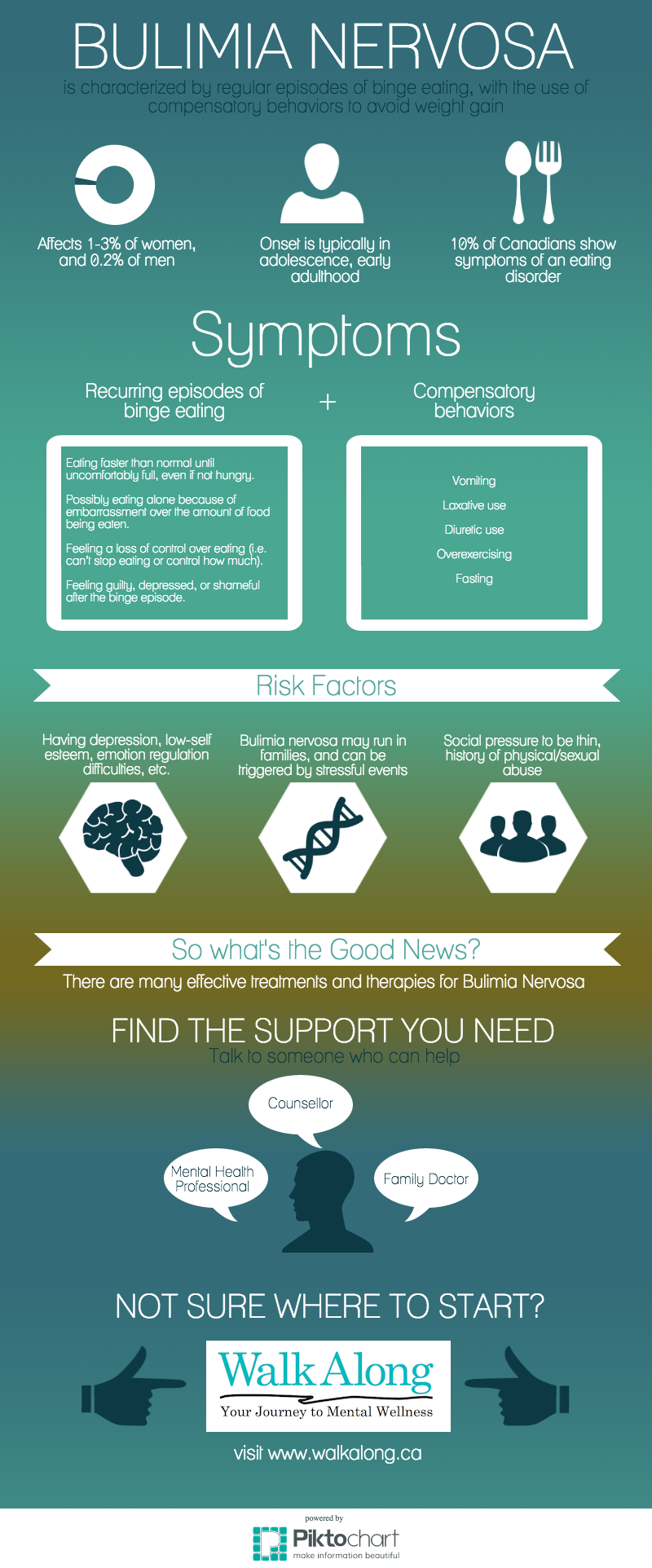Bulimia Nervosa (Bulimia)
Overview
Symptoms
Diagnosis
Causes & risk factors
Effects of Bulimia
Epidemiology
Treatment approaches
What can I do for myself?
Comorbidities
Summary
Infographic
Overview
Bulimia is a psychological disorder that affects an individual’s relationship with food and causes an unrealistic view of one’s body image. It is characterized by eating a large amount of food in a short period of time (bingeing) and then taking measures to get rid of it through vomiting or the use of laxatives (purging), fasting, and/or over-exercising due to fears of gaining weight.
Symptoms
Like individuals with Anorexia, those with Bulimia have an intense fear of gaining weight, a desire to lose weight, and a very negative body image. Unlike individuals with Anorexia, however, those with Bulimia go through binge-purge cycles in which they have recurring episodes of binge eating followed by compensatory behaviors (E.g. vomiting, laxative use, over-exercising, etc) in an attempt to avoid weight gain.
Individuals with binge-eating/purge type Anorexia tend to restrict their food intake but may occasionally purge regardless of whether they previously binged, whilst someone with Bulimia will have recurring episodes of binge-eating followed by purging. Symptoms of Bulimia are often hard to spot because the bulimic behaviors are often done in secret and are a source of shame, guilt and disgust. Bulimia is also hard to identify because individuals with Bulimia tend to fall within an average weight range for their age.
Physical
- Swollen salivary glands
- Broken blood vessels in eyes
- Puffy cheeks caused by repeated induced vomiting
- Discoloured teeth from stomach acid when vomiting
- Unstable weight
- Calluses, scars on hands from induced vomiting
Psychological
- Poor body image
- Low self-esteem
- Preoccupation with food, body shape, weight
- Feeling guilty, depressed or ashamed after an episode of binge-eating
- Difficulty dealing with stress, depression or anxiety
Behavioral
- Episodes of binge-eating (usually done in secret)
- Purging after a binge-eating episode (by vomiting or using laxatives, diet pills or diuretics)
- Obsessive exercising following a binge-eating episode
- Fasting following a binge-eating episode
- Frequent dieting
- Eating to deal with stress, depression or anxiety
Diagnosis
According to the DSM-5 criteria, to be diagnosed as having Bulimia Nervosa a person must display:
- Recurring episodes of binge eating. Binge eating is characterized by:
- Eating an amount of food (within 2 hours) that is larger than what most people would eat within this time period.
- Feeling a loss of control over eating within the time period (E.g. can’t stop eating or control how much).
- Recurring compensatory behaviour (E.g., vomiting, fasting, excessive exercise, and misuse of dieuretics, laxatives or other medications) to prevent weight gain.
- Binge eating episodes and compensatory behaviours occur on average at least once a week for 3 months.
- Self-image is heavily dependent on body shape and weight.
- The symptoms cannot occur simply during episodes of Anorexia Nervosa.
Click here to view the DSM-V criteria for Bulimia Nervosa.
Causes and Risk Factors
Psychological causes and risk factors
Individuals with Bulimia (and other eating disorders) tend to have trouble managing their emotions in healthy ways, and use their eating habits as an emotional release (of anger, sadness, anxiety or stress) or a way to cope. Having low self-esteem is also a risk factor for the development of Bulimia, as is having depression and a need for perfectionism.
Social causes and risk factors
Many cultures and societal norms also put much pressure on being thin, which can contribute to the onset and perpetuation of Bulimia. Being constantly exposed to an unrealistic body “ideal” can bring forth feelings of low self-esteem that in turn contributes to the development of an eating disorder. This includes certain activities that put an emphasis on a slim body type or particular weight (E.g. ballet, modeling, swimming or gymnastics) as well as the view portrayed in the media that thinness is attractive which can encourage a lifestyle in which one strives for thinness.
A history of trauma or abuse (especially sexual abuse) seems to coincide with a diagnosis of Bulimia. An individual with Bulimia is also more likely to have parents with a substance abuse problem.
Stressful life events (E.g. death of a loved one, break-up, going away to university) can also trigger an onset of Bulimia in an attempt to deal with ones emotions.
Biological causes and risk factors
Some research suggests that certain individuals have a genetic predisposition to developing Bulimia – those with an immediate family member (sibling or parent) with an eating disorder are more likely to develop one.
Effects of Bulimia Nervosa
Bulimia has many negative effects on the body, the most dangerous being dehydration caused by too much purging. Purging results in electrolyte imbalance in the body (usually low potassium levels), which results in many symptoms ranging in severity from “clouded thinking” and fatigue to an irregular heartbeat and death. If low potassium levels are maintained for a long time, it can result in kidney failure.
Some of the other physical symptoms of Bulimia that may develop are: overall weight gain, swollen cheeks, tooth decay, ruptured esophagus and/or stomach, anemia (low blood count), chronic bloating and constipation, loss of menstrual periods and increased chances of heart failure.
Click here to read more about the effects of Bulimia Nervosa.
Epidemiology
Between 1-3% of young females and 0.2% of young males in the United States meet the criteria for Bulimia [Read More]. It is more common in females (90%) and tends to develop in adolescence or early adulthood [Read More].
Treatment Approaches
Treatment for Bulimia tends to consist of Cognitive-Behavioral therapy (CBT), a form of psychotherapy where the goal is to change harmful thoughts (poor body image) and behaviors (binge-purge cycle).
CBT for Bulimia tends to being with putting an end to the binge-purge cycle and bringing back regular eating patterns. You will also track your eating patterns and learn how to cope with emotional stress in more productive ways that do not involve food, eat more frequently to avoid hunger cravings (and binges) and preventing purging. Next, the harmful thoughts associated with Bulimia are tackled – you learn to identify and change dysfunctional beliefs about body image and eating, and start determining your self-worth on things other than weight. The final stage involves dealing with the emotional issues that caused the onset of Bulimia, such as underlying psychological disorders (E.g. depression, anxiety), low self-esteem and detrimental relationships.
What Can I Do for Myself?
Making the choice to seek help or confide in someone about Bulimia is a very difficult choice to make - many feel like bingeing and purging is the only way they can deal with their emotions or stress. Recovery is possible.
Acknowledge that your obsession with your weight is a problem. Disregard the thoughts that tell you you’ll finally be happy once you reach a specific weight, and realize the amount of emotional and physical suffering that Bulimia has put you through. Try and grasp the fact that your fear of gaining weight is a symptom of your eating disorder, and that your binge-purge cycle relationship with food is unhealthy. Confiding in someone who can support you as you try to recover can be very beneficial.
Surround yourself with people, places and activities that promote a positive body image. Constantly being exposed to society’s “ideals”, friends/family who are overly concerned with their appearance, and messages promoting body shaming and Bulimia can make recovery all that more difficult.
Don’t be afraid to seek professional help. Counseling for your eating disorder is an extremely important part of the recovery process - doctors and psychologists can help you develop a healthy relationship with food and a more positive body image, as well as helping you deal with stressful situations in your life that don't involve self-destructive habits. Nutritionists/dieticians can teach you about healthy eating and assist in developing meal plans [Read More].
Comorbidities
Many people with Bulimia Nervosa often also have another psychological disorder. Major Depressive Disorder (Depression) occurs in 63% of people with Bulimia (present either before, during or after), and approximately 36% of people with Bulimia Nervosa also have an anxiety disorder [Read More]. Individuals with Bulimia Nervosa are also at higher risk for developing a substance abuse disorder.
Summary
Bulimia is a psychological disorder that affects an individual’s relationship with food, and causes an unrealistic view of one’s body image. It is characterized by eating a large amount of food in a short period of time (bingeing) and then taking measures to get rid of it through vomiting or the use of laxatives (purging), fasting, and/or over-exercising due to fears of gaining weight. Symptoms of Bulimia are often hard to spot because the bulimic behaviors are often done in secret and are a source of shame, guilt and disgust. It is also hard to identify because individuals with Bulimia tend to fall within an average weight for their age.
Bulimia has many negative effects on the body, the most dangerous being dehydration caused by too much purging. Between 1-3% of young females and 0.2% of young males in the United States meet the criteria for Bulimia [Read More]. It is more common in females (90%) and tends to develop in adolescence or early adulthood [Read More].
Treatment for Bulimia tends to consist of Cognitive-Behavioral therapy (CBT), a form of psychotherapy where the goal is to change harmful thoughts (poor body image) and behaviors (binge-purge cycle). Many people with Bulimia Nervosa often also have another psychological disorder. Major Depressive Disorder (Depression) occurs in 63% of people with Bulimia (present either before, during or after), and approximately 36% of people with Bulimia Nervosa also have an anxiety disorder [Read More]. Individuals with Bulimia Nervosa are also at higher risk for developing a substance abuse disorder.



